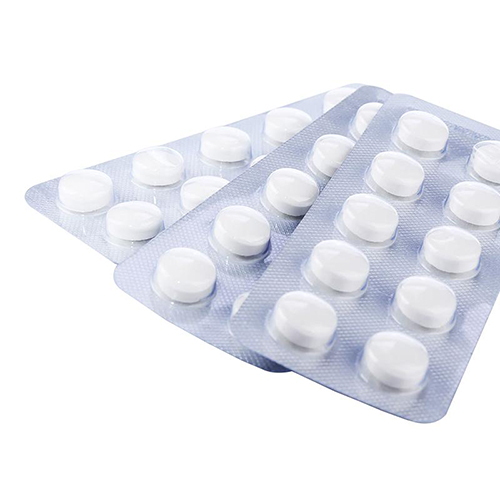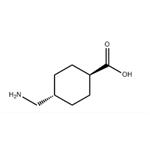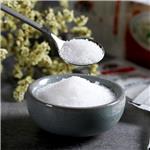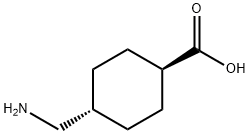Medical effects of tranexamic acid
Mar 30,2022
Introduction
Tranexamic acid, also known as tranexamic acid, tranexamic acid[1], hemostatic acid, molecular formula is C8H15NO2, molecular weight is 157.21, CAS number is 1197-18-8, chemical name is trans-4-aminomethylcyclohexanecarboxylic acid, It is a white crystalline powder, odorless, with a slight taste. Soluble in water, almost insoluble in ethanol, acetone, chloroform or ether. The melting point of tranexamic acid is 233 °C.

Picture 1 Tranexamic acid tablets
Pharmacology and toxicology
Fibrinolysis is related to fibrinolysis and increased vascular permeability in the body under physiological or pathological conditions, and is also associated with the development and cure of body reactions, various bleeding symptoms and allergic reactions caused by fibrinolysis. Tranexamic acid inhibits the action of this plasmin, and exhibits hemostatic, anti-allergic, and anti-inflammatory effects.
Anti-plasmin effect: Tranexamic acid can strongly adsorb to the lysine binding site (LBS) of the fibrin affinity site on plasmin and plasminogen, inhibiting plasmin, fibrinogen Lysinogen binds to fibrin, thereby strongly inhibiting fibrinolysis by plasmin. In addition, in the presence of antiplasmin such as ɑ2 macroglobulin in serum, the antifibrinolytic effect of tranexamic acid is more obvious, and the hemostatic effect is more significant.
Hemostatic effect: abnormally hyperactive plasmin will cause platelet aggregation inhibition and coagulation factor decomposition. Mild hyperactivity first leads to the breakdown of fibrin. Therefore, it is considered that in general bleeding, tranexamic acid can inhibit fibrinolysis and play a role in hemostasis.
Anti-allergic and anti-inflammatory effects: Tranexamic acid can inhibit the production of kinin and other active peptides (guinea pigs, rats) that cause increased vascular permeability, allergic reactions and inflammatory lesions.
Pharmacokinetics
The pharmacokinetic parameters of a single dose (500mg tablet) of this product in healthy adults with plasma concentration are as follows: Pharmacokinetic parameters of tranexamic acid when a single dose (500mg) is administered orally (n=5 ).
Distribution: When a single dose of C-tranexamic acid was orally administered to rats, the concentration of C-tranexamic acid in most organs was the same as the total blood drug concentration, and the highest concentration was shown 2 hours after administration; the blood drug concentration of kidney and liver was higher than Blood, other organs have lower concentrations of the drug than blood.
Metabolism and excretion: After a single oral dose of tranexamic acid tablets of 500 mg or 250 mg in healthy adults, it is rapidly absorbed. Twenty-four hours after administration, 40-70% of the administered dose is excreted unchanged in urine.
Indications
Trauma or surgical bleeding of organs rich in plasminogen activator such as prostate, urethra, lung, brain, uterus, adrenal gland, thyroid, liver, etc. Used as thrombolytic drugs, such as antagonists of tissue plasminogen activator (t-PA), streptokinase and urokinase. Fibrinolytic hemorrhage caused by induced abortion, early placental exfoliation, stillbirth and amniotic fluid embolism. Menorrhagia, anterior chamber bleeding and severe epistaxis with increased local fibrinolysis. It is used to prevent or reduce bleeding after tooth extraction or oral surgery in hemophilia patients with factor VIII or factor IX deficiency.
For mild hemorrhage caused by rupture of central aneurysm, such as subarachnoid hemorrhage and intracranial aneurysm hemorrhage, this product is better than other antifibrinolytics for hemostasis, but attention must be paid to the risk of cerebral edema or cerebral infarction. . As for severe patients with surgical indications, this product can only be used as an adjuvant drug. For the treatment of hereditary angioedema, it can reduce the frequency and severity of its attacks. Active bleeding in patients with hemophilia. It has definite curative effect on chloasma.
Cautions
The following patients should be administered with caution (1) Patients with thrombosis (cerebral thrombosis, myocardial infarction, thrombophlebitis, etc.) and patients who may cause thrombosis. [Tendency to stabilize thrombus] (2) Patients with consumptive coagulation disorders. (Combined use with heparin, etc.) [Tendency to stabilize thrombus] (3) Patients who are in a bedridden state after surgery and patients who are receiving compression for hemostasis. [The above situation is prone to venous thrombosis, and the thrombus tends to be stabilized after administration of this drug. There have been reports of pulmonary embolism after getting out of bed and decompression. (4) Patients with renal insufficiency [sometimes elevated blood levels] (5) Patients with a history of allergy to this agent.
Guidance on medication: tell the patient to take the tablet out of the PTP board and then take it (it has been reported that due to mistaken consumption of the PTP board, the hard acute angle part has penetrated into the esophageal mucosa, which will lead to more serious perforation and mediastinal sinusitis and other serious complications. disease).
Reference
1 State Pharmacopoeia Commission. Pharmacopoeia of the People's Republic of China: 2010 Edition: Part II [M]. Beijing: China Pharmaceutical Science and Technology Press, 2010.
- Related articles
- Related Qustion
- Tranexamic Acid: Pharmacological Effects and Adverse Effects May 30, 2024
Tranexamic acid inhibits plasmin formation, enhances hemostasis, and modulates melanocyte activity, with adverse effects including gastrointestinal discomfort and musculoskeletal pain.
- Side effects of Tranexamic acid Mar 8, 2022
Tranexamic acid (TXA) is a medication used to treat or prevent excessive blood loss from major trauma, postpartum bleeding, surgery, tooth removal, nosebleeds, and heavy menstruation.It is also used for hereditary angioedema.It is taken eit
1,2-phenylenediamine appears as colorless monoclinic crystals if pure; technical grade brownish-yellow crystals or a sandy brown solid. Used in manufacture of dyes, photography, organic synthesis.1,2-....
Mar 30,2022DrugsSodium hexametaphosphate is an inorganic substance with the molecular formula (NaPO3)6, white powder crystal.....
Mar 30,2022APITranexamic Acid
1197-18-8You may like
- Tranexamic Acid
-

- $93.00 / 1kg
- 2024-06-05
- CAS:1197-18-8
- Min. Order: 1kg
- Purity: 99%
- Supply Ability: 9000kg
- Amstat
-

- $80.00 / 1KG
- 2024-06-05
- CAS:1197-18-8
- Min. Order: 1KG
- Purity: 99%
- Supply Ability: 500
- Tranexamic Acid
-

- $0.00 / 1kg
- 2024-05-30
- CAS:1197-18-8
- Min. Order: 0.1kg
- Purity: 99%
- Supply Ability: 20000kg




